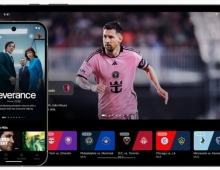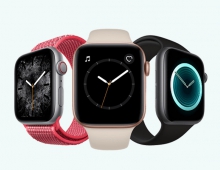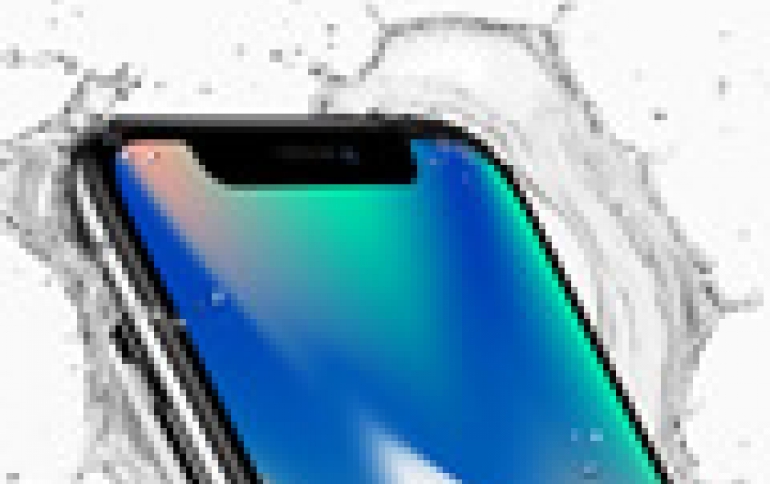
Apple Unveils iPhone X, iPhone 8 and 8 Plus, Apple TV 4K and Apple Watch 3
Apple on Tuesday rolled out its much-anticipated iPhone X, a redesigned product of glass and stainless steel with an edge-to-edge display that Apple Chief Executive Tim Cook called "the biggest leap forward since the original iPhone."
In short, the iPhone X features wireless charging, an infrared camera and special hardware for facial recognition, which will replace the fingerprint sensor for unlocking the phone. The home button found on previous iPhones is also gone, and users will instead tap the device to wake it up.
In an embarrassing moment for Apple senior vice president Craig Federighi, the face ID unlocking did not work on his first attempt during the on-stage presentation.
The phone, which is priced at $999 and ships on Nov. 3, as well as the holiday shopping season that will follow are the most important for Apple in years.
iPhone X details
The iPhone X has an all-glass design with a 5.8-inch Super Retina display. The screen on the iPhone X is about the size of the current iPhone 7 plus, though the phone itself is smaller. It features richer colors thanks to the new OLED technology, which vendors such as Samsung are also rolling out. Samsung Display is also the provider of the OLEd panels to Apple.
The all-glass front and back on iPhone X feature "the most durable glass ever in a smartphone" in two colors, silver and space gray. Highly polished, surgical-grade stainless steel band wraps around and reinforces iPhone X. The iPhone X is obviously durable while maintaining water and dust resistance.
The HDR display supports Dolby Vision and HDR10. The addition of True Tone dynamically adjusts the white balance of the display to match the surrounding light for a more natural, paper-like viewing experience.
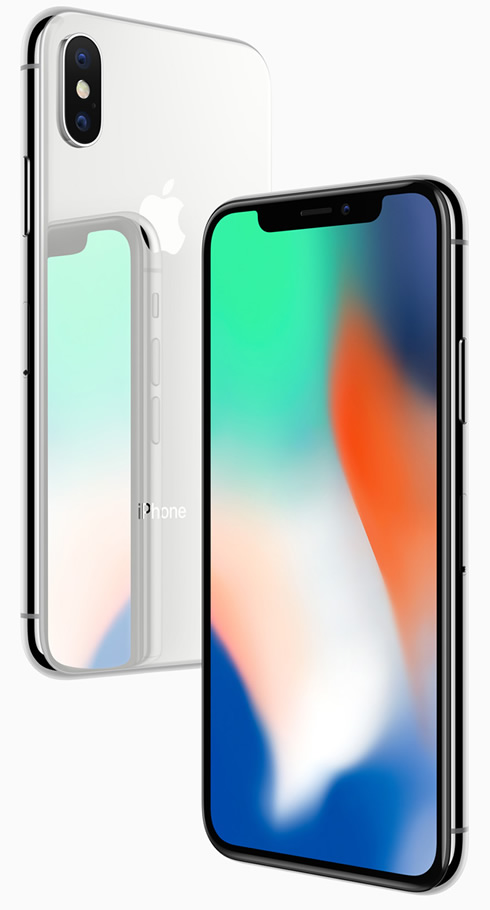
iOS 11 is redesigned to take full advantage of the Super Retina display and replaces the Home button with fast gestures, allowing users to navigate iPhone X. Simply swipe up from the bottom to go home from anywhere.
Face ID changes the authentication on iPhone X, using a TrueDepth camera system made up of a dot projector, infrared camera and flood illuminator, and is powered by A11 Bionic to accurately map and recognize a face. These depth-sensing technologies work together to unlock iPhone, enable Apple Pay, gain access to secure apps and many more new features.
Face ID projects more than 30,000 invisible IR dots. The IR image and dot pattern are pushed through neural networks to create a mathematical model of your face and send the data to the secure enclave to confirm a match, while adapting to physical changes in appearance over time. All saved facial information is protected by the secure enclave, while all of the processing is done on-device and not in the cloud to protect user privacy. Face ID only unlocks iPhone X when customers look at it and is designed to prevent spoofing by photos or masks.
The new 7-megapixel TrueDepth camera that enables Face ID features wide color capture, auto image stabilization and precise exposure control, and brings Portrait mode to the front camera for selfies with a depth-of-field effect.

iPhone X also features a redesigned dual 12-megapixel rear camera system with dual optical image stabilization. The f/1.8 aperture on the wide-angle camera joins an improved f/2.4 aperture on the telephoto camera for better photos and videos. A new color filter, deeper pixels and an improved Apple-designed image signal processor delivers advanced pixel processing, wide color capture, faster autofocus in low light and better HDR photos. A new quad LED True Tone Flash offers twice the uniformity of light and includes Slow Sync, resulting in more uniformly lit backgrounds and foregrounds.
The cameras on iPhone X are custom tuned for AR. Each camera is individually calibrated, with new gyroscopes and accelerometers for accurate motion tracking. The A11 Bionic CPU handles world tracking, scene recognition and the GPU enables incredible graphics at 60fps, while the image signal processor does real-time lighting estimation. With ARKit, iOS developers can take advantage of the TrueDepth camera and the rear cameras to create AR games and apps.
The new camera also delivers better video stabilization, 4K video up to 60fps and 1080p slo-mo up to 240fps. The Apple-designed video encoder provides real-time image and motion analysis for optimal quality video.
Portrait mode with Portrait Lighting on both the front and rear cameras brings dramatic studio lighting effects to iPhone and allows users to capture portraits with a shallow depth-of-field effect in five different lighting styles.

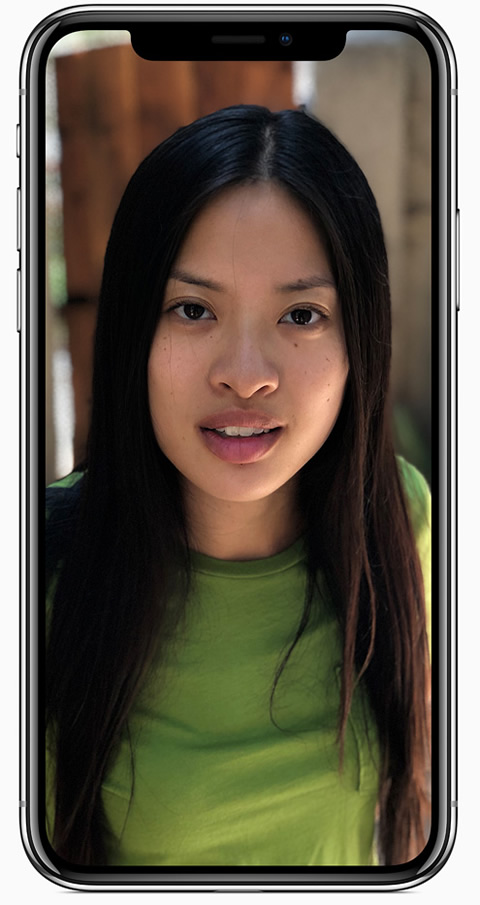
The TrueDepth camera brings emoji to life in a fun new way with Animoji. Working with A11 Bionic, the TrueDepth camera captures and analyzes over 50 different facial muscle movements, then animates those expressions in a dozen different Animoji, including a panda, unicorn and robot. Available as an iMessage app pre-installed on iPhone X, users can record and send Animoji messages with their voice that can smile, frown and more.
The A11 Bionic chipset features a six-core CPU design with two performance cores that are 25 percent faster and four efficiency cores that are 70 percent faster than the A10 Fusion. A new, second-generation performance controller can harness all six cores simultaneously, delivering up to 70 percent greater performance for multi-threaded workloads, giving more power while lasting two hours longer than iPhone 7. A11 Bionic also integrates an Apple-designed GPU with a three-core design that delivers up to 30 percent faster graphics performance than the previous generation.
The neural engine in A11 Bionic is purpose-built for machine learning, augmented reality apps and 3D games. The new neural engine is a dual-core design and performs up to 600 billion operations per second for real-time processing. A11 Bionic neural engine is designed for specific machine learning algorithms and enables Face ID, Animoji and other features.
The glass back design enables a wireless charging solution. Wireless charging works with the established Qi ecosystem, including two new wireless charging mats from Belkin and mophie, available from apple.com and Apple Stores.
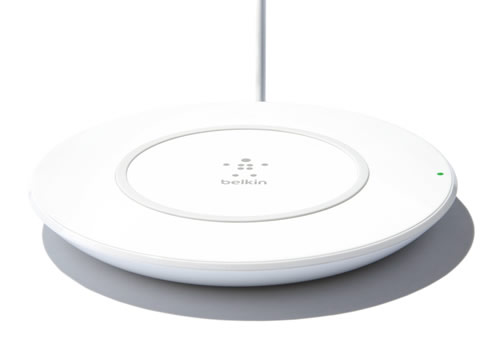
Apple also gave a sneak peek of AirPower, an Apple-designed wireless charging accessory coming in 2018, which offers a generous active charging area that will allow iPhone 8, iPhone 8 Plus or iPhone X owners to simultaneously charge up to three devices, including Apple Watch Series 3 and a new optional wireless charging case for AirPods.
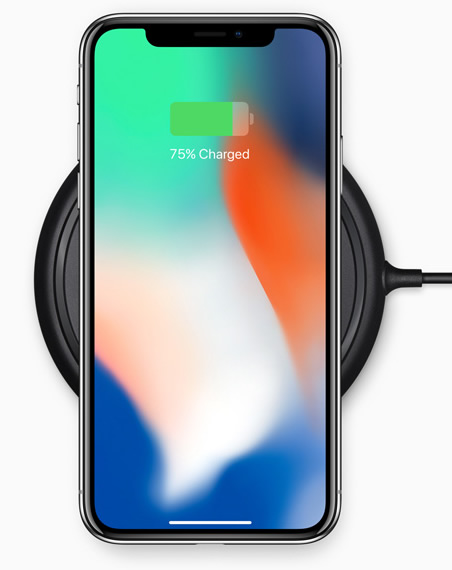
The iPhone X will be available in silver and space gray in 64GB and 256GB models starting at $999 (US). Through Apple's iPhone Upgrade Program, consumers in the US can get iPhone X, with the protection of AppleCare+, choose their carrier (no multiyear service contract required) and have the opportunity to upgrade to a new iPhone every year. The iPhone Upgrade Program is available for iPhone X at apple.com and Apple Stores in the US with monthly payments starting at $49.91.4
Consumers will be able to order iPhone X beginning Friday, October 27, with availability beginning Friday, November 3.
Apple-designed accessories including leather and silicone cases in a range of colors will be available starting at $35 (US), while a new iPhone X Leather Folio will be available for $99 (US). Lightning Docks in color-matching metallic finishes will also be available for $49 (US).
iPhone 8 and the iPhone 8 Plus
Apple also introduced the iPhone 8 and the iPhone 8 Plus, which resemble the iPhone 7 line but have a glass back for wireless charging.
The cheapest phones have 64 gigabytes of memory, up from 32 gigabytes in previous models, and will sell for $699 and $799.
The new iPhone features a glass and aluminum design in three colors made out of glass, Retina HD displays and A11 Bionic chip. The camera gets even better with single and dual cameras featuring Portrait Lighting on iPhone 8 Plus, and wireless charging brings a new capability to iPhone. Both devices will be available for pre-order beginning Friday, September 15 in more than 25 countries and territories, and in stores beginning Friday, September 22.
iPhone 8 and iPhone 8 Plus introduce a glass back design in three new finishes: space gray, silver and gold.
The new 4.7-inch and 5.5-inch Retina HD displays with the addition of True Tone adjust the white balance of the display to match the surrounding light. Redesigned stereo speakers are up to 25 percent louder and deliver deeper bass.

Each camera on the on iPhone 8 Plus is calibrated, with new gyroscopes and accelerometers for motion tracking. As in the case of the iPhone X, the A11 Bionic CPU handles world tracking, scene recognition and the GPU enables graphics at 60fps, while the image signal processor does real-time lighting estimation. With ARKit, iOS developers create AR games and apps.
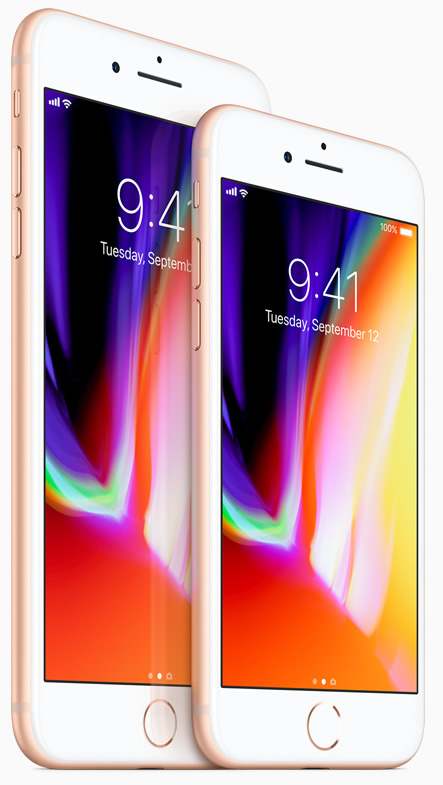
Both the iPhone 8 and iPhone 8 Plus models feature improved 12-megapixel camera with a larger and faster sensor, a new color filter and deeper pixels. Apple's new image signal processor delivers pixel processing, wide color capture, faster autofocus in low light and better HDR photos, while a new quad LED True Tone Flash with Slow Sync results in more uniformly lit backgrounds and foregrounds.
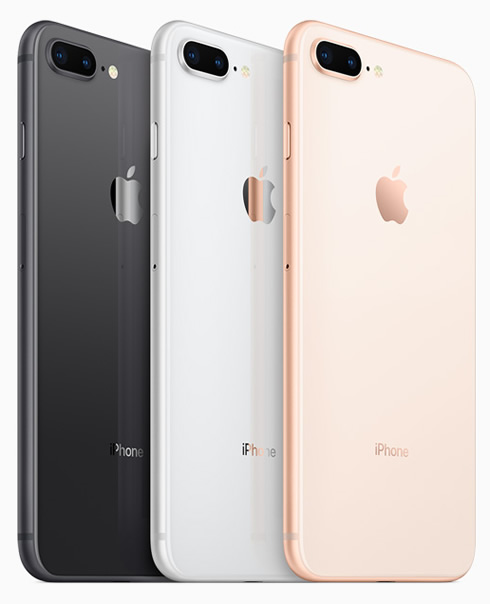
The new camera also delivers 4K video up to 60fps and 1080p slo-mo up to 240fps. The Apple-designed video encoder provides real-time image and motion analysis. With iOS 11, both iPhone 8 and iPhone 8 Plus support HEIF and HEVC for up to two times compression and storage for twice the photos and videos.
iPhone 8 Plus features dual 12-megapixel cameras and introduces Portrait mode with Portrait Lighting, bringing dramatic studio lighting effects to iPhone.
The glass back design enables wireless charging solution. Wireless charging works with the established Qi ecosystem, including two new wireless charging mats from Belkin and mophie, available from apple.com and Apple Stores. The phones are also compatible with the new Apple-designed AirPower mat, coming in 2018.

iPhone 8 and iPhone 8 Plus come with iOS 11, which bring augmented reality to iOS devices with a new platform for developers to build apps that let users place virtual content on top of real-world scenes. Siri debuts new male and female voices and can translate US English phrases into Chinese, French, German, Italian or Spanish.
iPhone 8 and iPhone 8 Plus will be available in space gray, silver and an all-new gold finish in increased 64GB and 256GB capacity models starting at $699 (US).
The iPhone Upgrade Program is available for iPhone 8 and iPhone 8 in the US with monthly payments starting at $34.50 for iPhone 8 and $39.50 for iPhone 8 Plus.3
Consumers will be able to order iPhone 8 and iPhone 8 Plus beginning Friday, September 15, with availability beginning Friday, September 22.
Apple Watch 3
The company also introduced an upgraded Apple Watch, which can make phone calls and access the internet without the user carrying an iPhone. The Series 3 watch will cost $399.
Wiith the Apple Watch Series 3, yoy can make calls, receive texts and more, even without iPhone nearby. The third-generation Apple Watch is a health and fitness companion with intelligent coaching features, water resistance 50 meters and a new barometric altimeter that measures relative elevation. Apple Watch Series 3 comes in two models, one with GPS and cellular, and one with GPS, both featuring a 70 percent faster dual-core processor and new wireless chip.
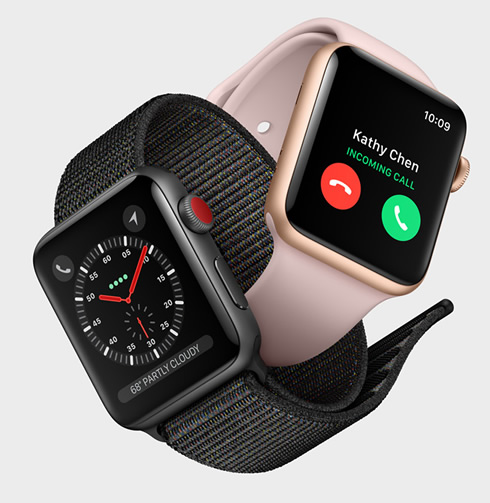
Soon, the combination of cellular and watchOS 4 will allow Apple Music users to stream 40 million songs right from their wrist. Beginning Friday, September 15, Apple Watch Series 3 (GPS + Cellular) will be available to order in 10 countries and territories, and Apple Watch Series 3 (GPS) will be available to order in 28 countries and territories. Both models are available in stores starting Friday, September 22.
Apple Watch Series 3 (GPS + Cellular) features a full LTE and UMTS cellular radio that switches to cellular when it is away from iPhone. The watch shares the same number as iPhone so there's no need to provide an additional number to family, friends or colleagues; and to help get customers started, participating carriers are also offering special introductory cellular plans at launch. Consumers have the ability to make cellular calls directly with Apple Watch Series 3 (GPS + Cellular) and, when paired with AirPods, enjoy a fully wireless experience. Apple also pioneered an industry-first antenna design that uses the display itself as both a transmitting and receiving element for LTE and UMTS, while introducing a built-in eSIM that is over one-hundredth the size of a traditional SIM card, making over-the-air activation possible without compromising space.
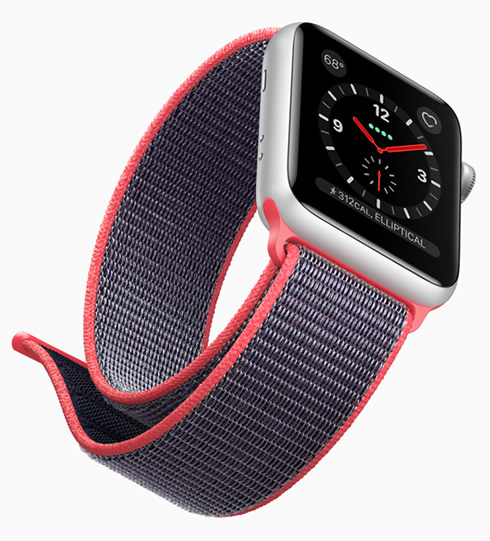
Powering Apple Watch Series 3 is the S3, Apple's third-generation architecture featuring a faster dual-core processor, which allows for quicker app launch times and smoother graphics, and, for the first time, enables Siri to speak using the built-in speaker. Apple designed a new custom wireless chip called W2, making Wi-Fi 85 percent faster and Bluetooth and Wi-Fi 50 percent more power efficient, while still providing all-day battery life and keeping the size virtually the same as before. Apple Watch Series 3 also features a barometric altimeter that assists with tracking activity, flights climbed and outdoor workouts, including elevation gain.
watchOS 4 features an updated Heart Rate app, giving even more insight to heart rate, including measurements during resting, workout, recovery, walking and Breathe sessions. Consumers can also choose to receive a notification when their heart rate is elevated above a specific threshold while inactive. Other watchOS 4 features include the proactive Siri watch face that displays the information users need most throughout the day, an enhanced Workout app with new interface, custom High Intensity Interval Training (HIIT) workout type and auto-sets for pool swims. With GymKit, users will soon enjoy the ability to connect to their favorite cardio equipment and experience two-way synchronization of data with just a tap, resulting in the most accurate information possible.

The redesigned Music app automatically syncs playlists like New Music Mix and Favorites Mix, along with the user's most listened to music. Later this fall, Apple Watch Series 3 (GPS + Cellular) will stream music, giving users access to any song from Apple Music, straight from the wrist. The new Radio app also enables listeners to access Beats 1 live or any Apple Music radio station while away from iPhone or Wi-Fi.

Apple Watch Series 3 pricing
Apple Watch Series 3 (GPS + Cellular) starts at $399 (US) and Apple Watch Series 3 (GPS) starts at $329 (US). Apple Watch Series 3 (GPS + Cellular) also debuts a special red Digital Crown and exclusive "Explorer" watch face that shows cellular connectivity through a unique design. Series 1 will be available at a new starting price of $249 (US).
In addition to silver or space gray aluminum, Apple Watch Series 3 now comes in a new gold aluminum, along with silver or space black stainless steel cases, which all pair with an assortment of new band colors and styles. The Woven Nylon is updated with a new pattern and the lightweight Sport Loop adjusts to fit wrists. Apple Watch Edition expands to include a dark gray ceramic case that pairs with a new two-toned Sport Band.
Apple Watch Nike+ has been popular, and this fall, the partnership continues with both models of Series 3 pairing with a new pure platinum/black Nike Sport Band or Sport Loop in exclusive colors. The Nike Run Club app has been updated to introduce new features: Audio Guided Runs deliver coaching and motivation from Nike's elite coaches, athletes and entertainers, while the Cheers feature makes running more fun by allowing your friends to send audio-based cheers, which will motivate you during a run. Just Do It Sundays continues to provide inspiration and rewards from participation in the world's largest running community. Apple Watch Hermes models come with built-in cellular and pair with a collection of new bands, including the Single Tour Rallye, in perforated Gala calfskin, inspired by the classic Hermes driving glove, and the Single Tour Eperon d'Or, in printed Gala calfskin, inspired by the equestrian scarf pattern designed by Henri d'Origny in 1974.
Apple Watch is available in two different case sizes, 38mm and 42mm. Apple Watch Series 3 (GPS + Cellular) will be available in gold, silver or space gray aluminum, or silver or space black stainless steel paired with a variety of bands starting at $399 (US). Apple Watch Series 3 (GPS) will be available in gold, silver or space gray aluminum cases with a Sport Band starting at $329 (US). Apple Watch Series 1 is available in silver or space gray aluminum cases paired with a Sport Band starting at $249 (US). Apple Watch Edition in gray or white ceramic will be available starting at $1,299 (US). Apple Watch Nike+ starts at $329 (US) and Apple Watch Hermes starts at $1,149 (US) (prices may vary).
- Consumers will be able to order Apple Watch Series 3 (GPS + Cellular) beginning Friday, September 15, with availability beginning Friday, September 22.
- Consumers will be able to order Apple Watch Series 3 (GPS) beginning Friday, September 15, with availability beginning Friday, September 22.
- Apple Watch Nike+ will be available to order beginning Friday, September 15, with limited availability on Thursday, October 5.
- Apple Watch Hermes will be available to order beginning Friday, September 15, with availability beginning Friday, September 22.
- New Apple Watch bands are available today.
- Apple Watch Series 3 (GPS + Cellular) requires iPhone 6 or later running iOS 11 or later and Apple Watch Series 3 (GPS) requires iPhone 5S or later running iOS 11 or later.
Apple TV 4K
Apple also announced the updated Apple TV. With support for both 4K and High Dynamic Range (HDR), Apple TV 4K features sharp, crisp images, richer, more true-to-life colors, and greater detail in both dark and bright scenes. With Apple TV 4K, viewers can enjoy a growing selection of 4K HDR movies on iTunes. iTunes users will get automatic upgrades of HD titles in their existing iTunes library to 4K HDR versions when they become available. Apple TV 4K will also offer 4K HDR content from video services, including Netflix and Amazon Prime Video, coming soon.
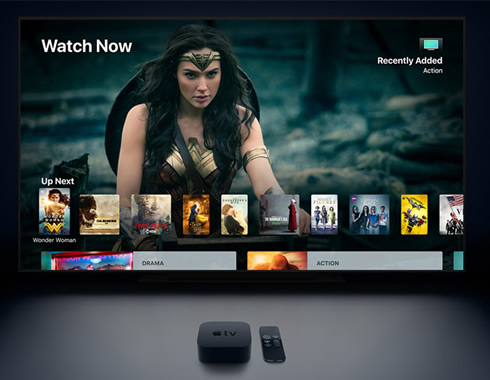
With the introduction of Apple TV 4K, the Siri Remote gets a redesign with a new white circle around the "menu" button.

Built on the A10X Fusion chip - the same chip that powers iPad Pro - the new Apple TV 4K deliversthe following.
- Support for both Dolby Vision and HDR10.
- Built-in high-performance 4K video scaler makes HD content look good on a 4K TV.
- Always outputting to the highest resolution possible allows viewers to get the most out of their TV, whether it's an older HDTV or the latest 4K Dolby Vision OLED.
- Automatic detection of a 4K TV's capabilities optimizes setup for the best quality picture.
Apple said that the TV app will expand to seven countries by the end of the year, making it easier for viewers to discover and watch TV shows and movies from multiple apps in one place.
Siri and the Apple TV app are easy ways to find and play what you want. The TV app brings all your favorite shows and movies together, and Siri makes it possible to search and access content across Apple TV using just your voice.
- The TV app supports over 60 services on Apple TV and iOS devices, with more being added all the time.
- Siri is smart about 4K HDR, so it's simple to find movies and TV shows in the highest picture quality across your apps
- Later this year, the TV app is making it easier to watch and get updates about live sports just by saying "Watch the Warriors game" or "What's the score of the Cubs game?"
- Sports fans in the US will be able to track their favorite teams and get on-screen notifications whenever they are playing, as well as see all the teams, leagues and sporting events currently playing through a dedicated Sports tab.
- Starting this month, the TV app will be available in Australia and Canada, in addition to the US. And, by the end of the year, it will expand to France, Germany, Norway, Sweden and the UK.
Apple TV 4K is a big screen companion to iPhone and iPad. Users have access to apps from the App Store on Apple TV, as well as photos, videos, music and more.

Users can share recent photos and videos from your iPhone and iPad, including the best Memories, with friends and family on the biggest screen, with iCloud on Apple TV.
It's also simple to send movies, TV shows, home videos and photos from iPhone or iPad to the TV using AirPlay from your iOS devices.
With support for AirPlay 2, coming later this year, Apple TV can control multiple AirPlay 2-compatible speakers as well as your home theater speakers. Apple TV goes beyond entertainment to help deliver on Apple's vision of the smart home. Since Apple TV is always at home, it's suited to act as a home hub for all of your HomeKit accessories, enabling remote access as well as automated control (e.g., automatically turning on the lights at sunset).
Apple TV 4K starts at $179 (US) for 32GB or $199 (US) for 64GB, joining Apple TV (4th generation) 32GB at $149 (US), available from apple.com and Apple Stores, as well as through select Apple Authorized Resellers and carriers (prices may vary). Both Apple TV 4K models will be available for ordering beginning Friday, September 15, with availability beginning Friday, September 22.

